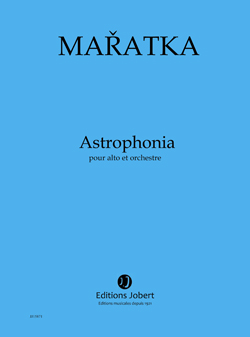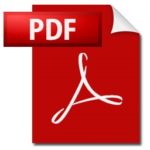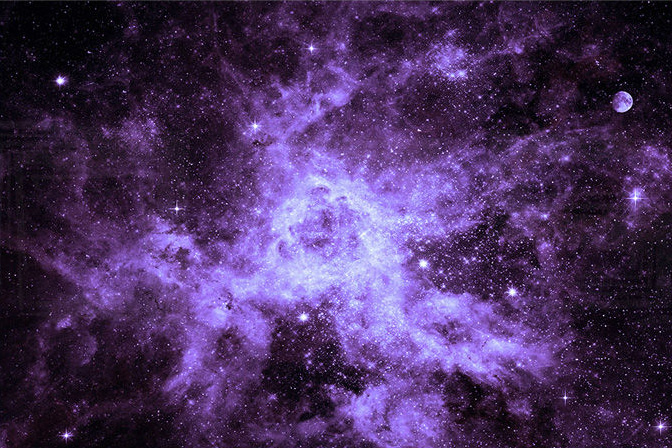ASTROPHONIA
concerto for viola and string orchestra with piano
(1998 / 2002)

Movements:
- I
- II
The execution of the first movement alone (11’) is possible, having been composed as an independent piece four years before the second movement. However, it is best to play the work in its entirety.
Duration: 25 min.
Commissioned by Radio France, the PACA Cannes Orchestra and the French State.
Instrumentation: solo viola, grand piano, string orchestra (minimum 3-3-2-2-1)
Premiere: Karine Lethiec (viola), Radio France Philharmonic Orchestra, 1999 (1st movement) Karine Lethiec (viola), PACA Cannes Regional Orchestra, Philippe Bender (conductor), December 2002 (complete work)
Publisher: The Henry Lemoine Editions display more information on this work on
http://www.henry-lemoine.com/fr/catalogue/compositeur/maratka-krystof
For more information, contact:
Henry Lemoine Editions – Paris
Mrs Laurence Fauvet - Rental and purchase of score
orchestre@editions-lemoine.fr / +33 (0) 1 56 68 86 75
Jobert Editions
Henry Lemoine Editions – Paris
Mr. Benoît Walther - Promotion and distribution service
bwalther@editions-lemoine.fr / +33 (0) 1 56 68 86 74
Jobert Editions
Recordings:
Extract of the score:
Notes on the work:
The fantasy concertante for viola and string orchestra with piano Astrophonia is inspired by the wonder aroused by of the starry sky. The solo part is the essence of the work, which originates from a “sound vision” of lyrical character, discreetly carried by the orchestra.
Two movements, two looks on the Universe...
Astrophonia was started in 1998, and the first of its two parts was completed in Prague in September of that same year. The second part followed only four years later, as it was completed on July 13th, 2002. It was a real challenge to take the work up again after such a long interval, as there was a real risk of heterogeneity between the two parts. The second part begins exactly where the first ended, and uninformed, no listener could locate the weld, especially if both pieces are executed almost without break.
Astrophonia is a Concerto for Viola, Strings and Piano. The latter is much more than an orchestral complement, yet it isn’t a second soloist, rather an autonomous sound layer, as indicated by the title “with piano”. The work is a poetic journey into interstellar spaces, towards infinity where time and space merge. Of course, there is no trace here of “sci-fi music”, none of its clichés. Rather, it is a very subjective meditation contemplating a universe in which there seems to be no place for an individual’s personal feelings. And it is precisely this contradiction that generates the music’s powerful tensions. The sound language is very free, some quasi-tonal associations never leading to a tonality as such, the material of the heights goes from unison to micro-tonal fluctuations, but also to noise at unspecified height. The vertical structures of the work result from a montage of different simultaneous layers. The composer himself indicates that the orchestra represents the static and out-of-time space and the piano the pulsed time, the soloist expressing the reactions of the human soul. But this distribution is actually much more subtle and complex, and in order to understand it we must define the different sound categories realized by the playing techniques, some of which are shared by two of the sound sources, sometimes even to all three.
Thus, the participation of the solo viola solo falls into three main categories: (1) long-held or rapidly fluctuating harmonic sounds, (2) melodic and lyrical lines, (3) fast and broken rhythms with harsh chord cries and percussive pizzicati. All three combine to form a solo part of impressive difficulty and virtuosity.
The orchestra produces five different sound categories: (1) long “held breaths” without pitch, a kind of soft “white noise” (that’s how the work begins), (2) held harmonic sounds (equivalent to the soloist’s category 1), (3) unisons on a clear and precise height, but superimposing different attacks and serving as a resting point or as a formal joint, (4) a polyphonic legato fabric with glissandi and micro-intervals (corresponding to category 2 of the soloist), and these are the most intensely expressive and most absolutely beautiful episodes of the piece, (5) rough, tense passages, even chaotic, of strongly rhythmic polyphony (corresponding to the soloist’s category 3).
The piano is implemented with an astonishing variety of sound effects, but there is in fact no “preparation” of the instrument in Cage’s way, nor amplification of any kind, all the sounds being perfectly “natural”. There are three different sound categories: (1) various percussive sounds, strong and brief, in the extreme low end of the instrument, pinching the strings with the fingers (corresponding to categories 3 of the soloist and 5 of the orchestra), ( 2) “normal” sounds in rapid lines in a spirit of cadence covering the full extent of the keyboard (corresponding to categories 2 of the soloist and 4 of the orchestra), (3) melodic lines played with a ruler placed on the strings, which gives ghostly harpsichord sounds, but also “noisy” sequences reminiscent of the African balafon.
These sound categories (eleven in total) are “mounted” in ever-changing combinations, each of two movements of the work being divided into eighteen short sequences played continuously. A detailed description would be as useless as boring. Let’s just say that the two movements share the same material and that some parts of the first are textually repeated in the second. Thus, the first movement has four main sections, the second and fourth of which are repeated in the third and fifth of the second movement. Because the second movement contains an extra section (after the second one), namely a real cadenza, where the solo viola joins the piano which exceptionally becomes a co-soloist, playing its “balafon” sounds combined for a short striking moment with natural sounds. One last detail: just before the coda (identical, we know it, to that of the first movement), the strings of the orchestra play an episode of ad libitum arpeggios in harmonic sounds, a late concession which grants them to also have a little cadential freedom. But the words are weak to express the intense poetic and sound seduction of this singular work for which the composer admits having a secret preference in his catalogue, which I am more than willing to share.
Harry HALBREICH


